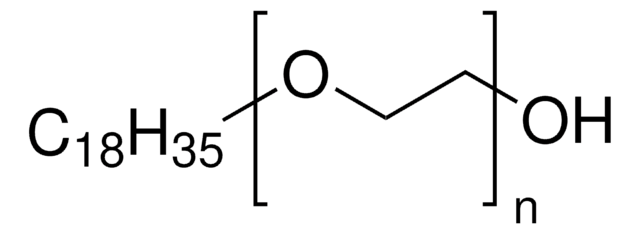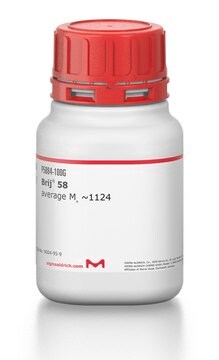STS0214
ECO BRIJ® O20
average Mn ~1,150
Sinonimo/i:
BRIJ® O20, Polyoxyethylene (20) oleyl ether
About This Item
Prodotti consigliati
Descrizione
non-ionic
Livello qualitativo
Stato
solid
PM
average Mn ~1,150
Caratteristiche più verdi
Use of Renewable Feedstocks
Design for Degradation
Learn more about the Principles of Green Chemistry.
sustainability
Greener Alternative Product
Punto di fusione
25-30 °C (lit.)
Indice di ossidrile
50‑65 mg KOH/g
Solubilità
water: soluble 1 g/L at 20 °C
Densità
0.901 g/cm3 at 20 °C
HLB
15.5
Categoria alternativa più verde
Stringa SMILE
O(CCO)CCCCCCCC\C=C/CCCCCCCC
InChI
1S/C20H40O2/c1-2-3-4-5-6-7-8-9-10-11-12-13-14-15-16-17-19-22-20-18-21/h9-10,21H,2-8,11-20H2,1H3/b10-9-
KWVPFECTOKLOBL-KTKRTIGZSA-N
Cerchi prodotti simili? Visita Guida al confronto tra prodotti
Descrizione generale
Caratteristiche e vantaggi
- 100 % Renewable
- 100 % Bio-based
- Certified to the USDA BioPreferred Program
- Lower carbon footprint than petrochemical-based versions
- High-purity chemical suitable for a wide variety of research applications
Altre note
Note legali
Avvertenze
Warning
Indicazioni di pericolo
Consigli di prudenza
Classi di pericolo
Aquatic Chronic 2 - Skin Irrit. 2
Codice della classe di stoccaggio
11 - Combustible Solids
Classe di pericolosità dell'acqua (WGK)
WGK 1
Punto d’infiammabilità (°F)
>464.0 °F - Equilibrium method
Punto d’infiammabilità (°C)
> 240 °C - Equilibrium method
Scegli una delle versioni più recenti:
Certificati d'analisi (COA)
It looks like we've run into a problem, but you can still download Certificates of Analysis from our Documenti section.
Se ti serve aiuto, non esitare a contattarci Servizio Clienti
Possiedi già questo prodotto?
I documenti relativi ai prodotti acquistati recentemente sono disponibili nell’Archivio dei documenti.
Il team dei nostri ricercatori vanta grande esperienza in tutte le aree della ricerca quali Life Science, scienza dei materiali, sintesi chimica, cromatografia, discipline analitiche, ecc..
Contatta l'Assistenza Tecnica.




